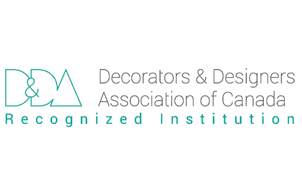|
Program Outcomes
Upon completion of the program, students will be able to:
- Recognize the difference between interior decorators and interior designers, and understand employment opportunities in the interior decorating field, interviewing techniques, and the characteristics of a successful decorator in different specialty areas and for different types of clients.
- Identify clients’ needs by recognizing their basic physical and psychological needs, understanding the clients’ goals along with their budgets and priorities, and determining a client’s preferences in regard to furniture styles, colors, fabrics, textures, and patterns.
- Identify the elements and principles of design including line, form, color, value, texture, pattern, light, space, proportion, scale, emphasis, and unity and recognize whether elements and principles of design have been successfully applied to a décor by understanding the importance of the function of the room.
- Distinguish the importance of color, recognize how color affects people and how color balance is created within a room; identify primary, secondary, and intermediate colors, and categorize their placement on the color circle.
- Recognize various color schemes based on the color circle, how colors affect each other, and how the amount of light and various surfaces can affect color.
- Identify the four general categories of furniture styles most widely used today and recognize typical furniture pieces from the past to present day and the periods during which these pieces originated.
- Identify furniture quality and workmanship to meet a client’s needs based on the best use, as well as appearance, and recognize traffic patterns and how to create a focal point in a room by understanding harmonious furniture arrangements, including how to balance line, object, and space.
- Recognize how to measure a room, make rough sketches, prepare an accurate scaled plan, and use furniture templates
Understand the importance of floor treatments and how lighting effects floor treatments, the differences between types of flooring and floor coverings, the differences and characteristics between carpets and rugs, and how to select and use appropriate finishes on floors.
- Distinguish between various architectural features of walls including the use color, texture, and patterns in choosing wall treatments for specific décor and recognizing how to create scaled elevations.
- Recognize how to choose window treatments including shades, blinds, shutters, and panels to suit many decorating situations, and understand accurate measurements and yardage requirements for curtains, draperies and window treatments, in addition to studying how to draw windows to scale on an elevation.
- Identify a wide variety of architectural symbols and terms while reading blueprints.
- Recognize the three types of house plan layouts according to their activity zones and room by room problem areas and the solutions.
- Understand the characteristics of natural and synthetic fibers, the types of special fabric finishes, types of knits, yarns, common weaves and fabric yardage requirements, in addition to, the information on an upholstery tag.
- Understand how to light a room and choose accessories to meet all of your client’s needs and desires according to the selection of paint, fabric, wallpaper, and specific situations to meet a room’s style, and mood.
- Identify the three types of residential lighting and distinguish between incandescent and fluorescent lighting, and the effects of natural and artificial light on specific colors of décor.
- Comprehend how to plan spaces for home offices, home fitness centers, and home entertainment rooms by recognizing how to choose furniture for these rooms, based on anthropometric and ergonomic principles.
- Understand the concept of selling and how to approach a client by learning how to look for new clients, how to present merchandise, develop a follow-up system, and write appropriate thank-you notes.
- Comprehend how to establish yourself as a professional by studying how to assemble a decorating team, and expand your clientele, identify the subcontractors, tradespeople, and custom fabricators, and recognizing how to set up a studio or office, locate suppliers, set up a source file, and how to keep records for income and self-employment taxes.
- Develop a decorating plan for a living room and submit specific information regarding the plan along with photographs, floor plans, paint chips, fabric swatches, window treatments, and elevations.
- Pass the cumulative final examination.
|

